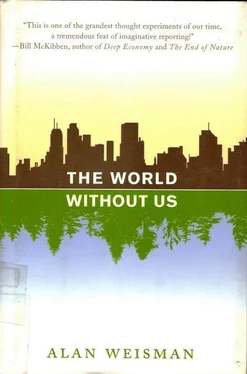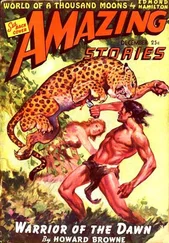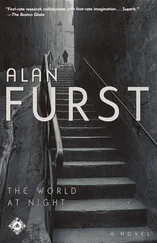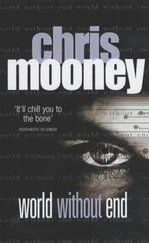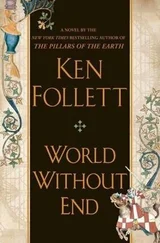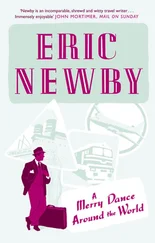Within recent historic times, reefs swarmed with 800-pound groupers, codfish could be dipped from the sea by lowering baskets, and oysters filtered all the water in Chesapeake Bay every three days. The planet’s shores teemed with millions of manatees, seals, and walruses. Then, within a pair of centuries, coral reefs were flattened and sea-grass beds were scraped bare, the New Jersey-sized dead zone appeared off the mouth of the Mississippi, and the world’s cod collapsed.
Yet despite mechanized overharvesting, satellite fish-trackers, nitrate flooding, and prolonged butchery of sea mammals, the ocean is still bigger than we are. Since prehistoric man had no way to pursue them, it’s the one place on Earth besides Africa where big creatures eluded the intercontinental megafaunal extinction. “The great majority of sea species are badly depleted,” says Jeremy Jackson, “but they still exist. If people actually went away, most could recover.”
Even, he adds, if global warming or ultraviolet radiation bleaches Kingman and Australia’s Great Barrier Reef to death, “they’re only 7,000 years old. All these reefs were knocked back over and over by the ice ages, and had to form again. If the Earth keeps getting warmer, new reefs will appear farther to the north and south. The world has always changed. It’s not a constant place.”
Nine-hundred miles northwest of Palmyra, the next visible turquoise-ringed smudge of land rising from the blue Pacific depths is Johnston Atoll. Like Palmyra, it was once a U.S. seaplane base, but in the 1950s it became a Thor missile nuclear test range. Twelve thermonuclear warheads were exploded here; one that failed scattered plutonium debris over the island. Later, after tons of irradiated soil, contaminated coral, and plutonium were “decommissioned” into a landfill, Johnston became a post-Cold War chemical-weapons incineration site.
Until it closed in 2004, sarin nerve gas from Russia and East Germany, along with Agent Orange, PCBs, PAHs, and dioxins from the United States, were burned there. Barely one square mile, Johnston Atoll is a marine Chernobyl and Rocky Mountain Arsenal rolled into one—and like the latter, its latest incarnation is as a U.S. National Wildlife Refuge.
Divers there report seeing angelfish with herringbone chevrons on one side and something resembling a cubist nightmare on the other. Yet, despite this genetic jumble, Johnston Atoll is not a wasteland. The coral seems reasonably healthy, thus far weathering—or perhaps inured to—temperature creep. Even monk seals have joined the tropicbirds and boobies nesting there. At Johnston Atoll, as at Chernobyl, the worst insults we hurl at nature may stagger it, but nowhere as severely as our overindulged lifestyle.
One day, perhaps, we will learn to control our appetites, or our duplication rates. But suppose that before we do, something implausible swoops in to do that for us. In just decades, with no new chlorine and bromine leaking skyward, the ozone layer would replenish and ultraviolet levels subside. Within a few centuries, as most of our excess industrial CO 2dissipated, the atmosphere and shallows would cool. Heavy metals and toxins would dilute and gradually flush from the system. After PCBs and plastic fibers recycled a few thousand or million times, anything truly intractable would end up buried, to one day be metamorphosed or subsumed into the planet’s mantle.
Long before that—in far less time than it took us to run out of codfish and passenger pigeons—every dam on Earth would silt up and spill over. Rivers would again carry nutrients to the sea, where most life would still be, as it was long before we vertebrates first crawled onto these shores.
Eventually, we’d try that again. Our world would start over.
CODA

Our Earth, Our Souls
AS THE SAYING goes, we don’t get out of this life alive—and neither will the Earth. Around 5 billion years from now, give or take, the sun will expand into a red giant, absorbing all the inner planets back into its fiery womb. At that point, water ice will thaw on Saturn’s moon Titan, where the temperature is currently –290°F, and some interesting things may eventually crawl out of its methane lakes. One of them, pawing through organic silt, might come across the Huygens probe that parachuted there from the Cassini space mission in January, 2005, which, during its descent, and for 90 minutes before its batteries died, sent us pictures of streambed-like channels cutting down from orange, pebbled highlands to Titan’s sand-dune seas.
Sadly, whatever finds Huygens won’t have any clue where it came from, or that we once existed. Bickering among project directors at NASA nixed a plan to include a graphic explanation that Jon Lomberg designed, this time encased in a diamond that would preserve a shred of our story at least 5 billion years—long enough for evolution to provide another audience.
More crucial to us still here on Earth, right now, is whether we humans can make it through what many scientists call this planet’s latest great extinction—make it through, and bring the rest of Life with us rather than tear it down. The natural history lessons we read in both the fossil and the living records suggest that we can’t go it alone for very long.
Various religions offer us alternative futures, usually elsewhere, although Islam, Judaism, and Christianity mention a messianic reign on Earth lasting, depending on whose version, somewhere from seven to 7,000 years. Since these would apparently follow events that result in severe population reduction of the unrighteous, this might be feasible. (Unless, as all three suggest, the dead would be resurrected, which could trigger both resource and housing crises.)
However, since they disagree about who are the righteous, to believe any one of them requires an act of faith. Science offers no criteria by which to pick survivors other than evolution of the fittest, and into every creed are born similar percentages of stronger and weaker individuals.
As to the fate of the planet and its other residents after we’re finally done with it—or it’s done with us—religions are dismissive, or worse. The posthuman Earth is either ignored or destroyed, although in Buddhism and Hinduism, it starts again from scratch—as does the whole universe, similar to a repeating Big Bang theory. (Until that happens, the correct answer to whether this world would go on without us, says the Dalai Lama, is: “Who knows?”)
In Christianity, the Earth melts, but a new one is born. Since it needs no sun—the eternal light of God and the Lamb having eliminated night—it’s clearly a different planet than this one.
“The world exists to serve people, because man is the most honorable of all creatures,” says Turkish Sufi master Abdülhamit Çakmut. “There are cycles in life. From the seed comes the tree, from the tree comes the fruit we eat, and we give back as humans. Everything is meant to serve man. If people are gone from this cycle, nature itself will be over.”
The Muslim dervish practice he teaches reflects the recognition that everything, from atoms to our galaxy, whirls in cycles, including nature as it continually regenerates—at least until now. Like so many others—Hopis, Hindus, Judeo-Christians, Zoroastrians—he warns of an end-time. (In Judaism, time itself is said to end, but only God knows what that means.) “We see the signs,” Çakmut says. “Harmony is broken. The good are outnumbered. There is more injustice, exploitation, corruption, pollution. We are facing it now.”
It’s a familiar scenario: Good and evil finally spin apart, landing in heaven and hell, respectively, and everything else vanishes. Except, Abdülhamit Çakmut adds, we can slow this process—the good are those who strive to restore harmony and speed nature’s regeneration.
Читать дальше
